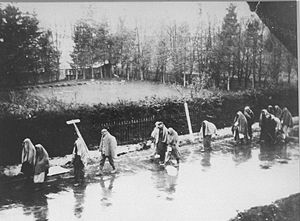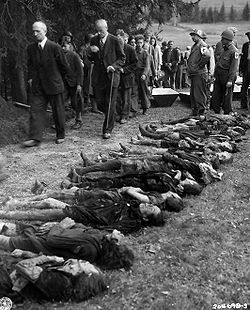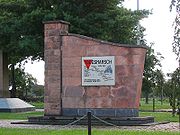
Death marches (Holocaust)
Encyclopedia

Nazi Germany
Nazi Germany , also known as the Third Reich , but officially called German Reich from 1933 to 1943 and Greater German Reich from 26 June 1943 onward, is the name commonly used to refer to the state of Germany from 1933 to 1945, when it was a totalitarian dictatorship ruled by...
of thousands of prisoners from German concentration camps near the war front to camps inside Germany.
General


World War II
World War II, or the Second World War , was a global conflict lasting from 1939 to 1945, involving most of the world's nations—including all of the great powers—eventually forming two opposing military alliances: the Allies and the Axis...
in 1944, as Britain and the United States
United States
The United States of America is a federal constitutional republic comprising fifty states and a federal district...
approached the concentration camps from the west, the Soviet Union
Soviet Union
The Soviet Union , officially the Union of Soviet Socialist Republics , was a constitutionally socialist state that existed in Eurasia between 1922 and 1991....
was advancing from the east. Trapped in the middle of the allied advance, the SS, not wanting the world to know about the Holocaust, decided to abandon the camps, moving or destroying evidence of the various atrocities they had committed there. Thousands of prisoners were killed in the camps before the marches commenced. These executions were deemed crimes against humanity during the Nuremberg trials
Nuremberg Trials
The Nuremberg Trials were a series of military tribunals, held by the victorious Allied forces of World War II, most notable for the prosecution of prominent members of the political, military, and economic leadership of the defeated Nazi Germany....
.
Although the prisoners were already weak or ill after enduring the routine violence, overwork and starvation of concentration camp life, they were marched for dozens of miles in the snow to railway stations, then transported for days at a time without food, water or shelter in freight carriages originally designed for cattle
Cattle
Cattle are the most common type of large domesticated ungulates. They are a prominent modern member of the subfamily Bovinae, are the most widespread species of the genus Bos, and are most commonly classified collectively as Bos primigenius...
. On arrival at their destination, they were then forced to march again to the new camp. Any prisoners who were unable to keep up due to fatigue or illness were immediately executed by gunshot.
The first evacuation of Majdanek
Majdanek
Majdanek was a German Nazi concentration camp on the outskirts of Lublin, Poland, established during the German Nazi occupation of Poland. The camp operated from October 1, 1941 until July 22, 1944, when it was captured nearly intact by the advancing Soviet Red Army...
inmates started in April 1944. Prisoners of Kaiserwald were transported to Stutthof
Stutthof concentration camp
Stutthof was the first Nazi concentration camp built outside of 1937 German borders.Completed on September 2, 1939, it was located in a secluded, wet, and wooded area west of the small town of Sztutowo . The town is located in the former territory of the Free City of Danzig, 34 km east of...
or killed in August.
Mittelbau-Dora
Mittelbau-Dora
Mittelbau-Dora was a Nazi Germany labour camp that provided workers for the Mittelwerk V-2 rocket factory in the Kohnstein, situated near Nordhausen, Germany....
was evacuated in April 1945.
The SS killed large numbers of prisoners in gas chambers
Gas Chambers
Gas Chambers is a fast, hollow and shallow point break type of wave. Being that it is a high performance wave it is well suited for the average to pro level surfer. Gas Chambers is located on the North Shore of Oahu about a 1/4 of a mile north of Ehukai Beach Park and 1/2 a mile west of Sunset...
, by lethal injection
Lethal injection
Lethal injection is the practice of injecting a person with a fatal dose of drugs for the express purpose of causing the immediate death of the subject. The main application for this procedure is capital punishment, but the term may also be applied in a broad sense to euthanasia and suicide...
and by starvation before the marches, and shot dead many more both during and after the death marches. Seven hundred prisoners were killed during one ten-day march of 8,000 Jews, including 6,000 women, who were being moved from camps in the Danzig
Gdansk
Gdańsk is a Polish city on the Baltic coast, at the centre of the country's fourth-largest metropolitan area.The city lies on the southern edge of Gdańsk Bay , in a conurbation with the city of Gdynia, spa town of Sopot, and suburban communities, which together form a metropolitan area called the...
region, which is bordered on the north by the Baltic Sea
Baltic Sea
The Baltic Sea is a brackish mediterranean sea located in Northern Europe, from 53°N to 66°N latitude and from 20°E to 26°E longitude. It is bounded by the Scandinavian Peninsula, the mainland of Europe, and the Danish islands. It drains into the Kattegat by way of the Øresund, the Great Belt and...
. Those still alive when the marchers reached the coast were forced into the sea and shot.
Elie Wiesel
Elie Wiesel
Sir Eliezer "Elie" Wiesel KBE; born September 30, 1928) is a Hungarian-born Jewish-American writer, professor, political activist, Nobel Laureate, and Holocaust survivor. He is the author of 57 books, including Night, a work based on his experiences as a prisoner in the Auschwitz, Buna, and...
, Holocaust survivor and winner of the 1986 Nobel Peace Prize
Nobel Peace Prize
The Nobel Peace Prize is one of the five Nobel Prizes bequeathed by the Swedish industrialist and inventor Alfred Nobel.-Background:According to Nobel's will, the Peace Prize shall be awarded to the person who...
, was forced on a death march, along with his father, Shlomo, from Buna to Buchenwald, which he describes in his 1958 book Night
Night (book)
Night is a work by Elie Wiesel about his experience with his father, Shlomo, in the Nazi German concentration camps at Auschwitz and Buchenwald in 1944–1945, at the height of the Holocaust and toward the end of the Second World War...
.
Auschwitz to Wodzisław Śląski
The best known of the death marches took place in January 1945, when the Soviet army advanced on occupied Poland. Nine days before the Soviets arrived at the death camp at Auschwitz, the SS marched nearly 60,000 prisoners out of the camp toward Wodzisław Śląski (German: Loslau), 35 miles away, where they were put on freight trains to other camps. Approximately 15,000 prisoners died on the way.Atlas of the Holocaust, Martin Gilbert
Martin Gilbert
Sir Martin John Gilbert, CBE, PC is a British historian and Fellow of Merton College, University of Oxford. He is the author of over eighty books, including works on the Holocaust and Jewish history...
, map of forced marches.
External links
- Map (from the U.S. Holocaust Memorial Museum)
- A map of the Death March of Brandenburg, by Iwo Cyprian PogonowskiIwo Cyprian PogonowskiIwo Cyprian Pogonowski is a Polish–, Belgian– and American–educated inventor and civil and industrial engineer with 50 patents to his credit...

